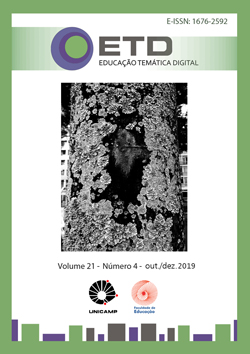Abstract
What if there is no waiting for the time in re-existence if it does not stop and does not pass? To give up on time through(out) experimentations with images, sculptures, cells, fluids to drill the upcoming. Moviments that can provoke us to pour in live red with Tunga and Cildo Meireles’s art. To withdraw from life, from body and from the resistance, the need of a lived time of biological conceptual precisions. And to leek around the edges of a red, dragged by signs of art. Women seaming (des)educations. Women who dare to sharp the times rifling. And, with it, to abandon the certainties and explanations for an aesthetic experience. To desire to lose the human and organic form that seeks to organize bodies, movements, thoughts, resistances and fights. And to invite for this confront creative desires and forces to produce what is broken to itself, what is ephemeral and generates pulses. To become. To pulse from the middle of the earth, from the street, from the university, from the classroom, from the museums knowledge, from the arts. Art-bio-life that drags a logos to chaotic rhythms-gestures in a mutant time produced in the singularity. We are the time. The pulses of a life (s)in education.
References
CESAR, Ana Cristina. A Teus Pés (1982). In: Os cem melhores poemas brasileiros do século. [seleção e organização Ítalo Moriconi]. Rio de Janeiro: Objetiva, 2001.
DELEUZE, Gilles. Lógica do Sentido. 4.ed. Trad. Luiz Roberto Salinas Fortes. São Paulo: Perspectiva. 2003.
DELEUZE, Gilles; GUATTARI, Félix. Mil Platôs. Vol 4. Trad. Suely Rolnik. São Paulo: Ed.34. 2.reimp., 2005. 176p.
DELEUZE, Gilles; GUATTARI, Félix. O anti-édipo. Trad. Luiz B. L. Orlandi. São Paulo: Ed.34. 2010. 560p.
DELEUZE, Gilles; PARNET, Claire. Diálogos. São Paulo: Escuta, 1998.
FERRAZ, Sílvio. Deleuze, música, tempo e forças não sonoras. In: ArteFilosofia, Ouro Preto, n.9, p. 67-76, out, 2010. Disponível em: http://www.periodicos.ufop.br/pp/index.php/raf/article/view/634. Acesso em: 20 dez. 2017.
GIL, José. Ritornelo e imanência. In: LINS, Daniel; GIL, José. (Org.). Nietzsche/Deleuze: jogo e música. Rio de Janeiro: Forense Universitária. Fortaleza/CE: Fundação de Cultura, Esporte e Turismo, 2008.
GODINHO, Ana. Diagramas para pensar/diagramas de sensação. In: GALLO, S.; NOVAES, M.; GUARIENTI, L. B. O. (Org). Conexões: Deleuze e políticas e resistências e... Petrópolis, RJ: DP&A; Campinas, SP: ALB; Brasília, DF: Capes, 2013.
MATESCO, Viviane. O corpo nas performances de Tunga, 2006. Disponível em: http://revistacaju.com.br/2016/07/19/tunga/. Acesso em: 20 fev. 2019.
MOORE, Marlon Rachquel. Opposed to the being of Henrietta: bioslavery, pop culture and the third life of HeLa cells. In: Medical Humanities, n. 43, p. 55-61, 2017.
NOGUEIRA, Fernanda. Metamorfose ambulante A desidentificação carnavalesca de Ney Matogrosso na militadura brasileira. In: ETD - Educação Temática Digital, Campinas, SP, v. 18, n. 4, p. 769-788, nov. 2016. ISSN 1676-2592. Disponível em: https://periodicos.sbu.unicamp.br/ojs/index.php/etd/article/viewFile/8646425/14497. Acesso em: 20 nov. 2018.
OLIVEIRA, Vinícius Abrahão de. Indigentes. In: PAJEÚ, Hélio Márcio (Org.). I LITERO-RODAS 2016: poesias, contos e crônicas. São Carlos: Pedro & João, 2016. p. 51-54.
VINDEL GAMONAL, Jaime. Arte y política: genealogía crítica de las estrategias conceptuales en el arte argentino entre 1965 y 2001. 2010. 555 f. Tese (Doutorado em História da Arte) -Faculdade de Filosofía e Letras, Universidade de León, León, Espanha, 2010. Disponível em: http://goo.gl/SvAe6x. Acesso em: 15 ago. 2016.
ZIELINSKI, Sara. Henrietta Lacks’ ‘Immortal’ Cells. Disponível em: https://www.smithsonianmag.com/science-nature/henrietta-lacks-immortal-cells-6421299/. Acesso em: 20 fev. 2019.
The ETD - Digital Thematic Education uses the Creative Commons license (CC), thus preserving the integrity of the articles in an open access environment.


